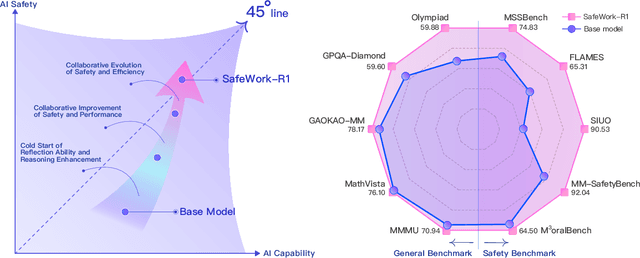Zhenyun Yin
SafeWork-R1: Coevolving Safety and Intelligence under the AI-45$^{\circ}$ Law
Jul 24, 2025



Abstract:We introduce SafeWork-R1, a cutting-edge multimodal reasoning model that demonstrates the coevolution of capabilities and safety. It is developed by our proposed SafeLadder framework, which incorporates large-scale, progressive, safety-oriented reinforcement learning post-training, supported by a suite of multi-principled verifiers. Unlike previous alignment methods such as RLHF that simply learn human preferences, SafeLadder enables SafeWork-R1 to develop intrinsic safety reasoning and self-reflection abilities, giving rise to safety `aha' moments. Notably, SafeWork-R1 achieves an average improvement of $46.54\%$ over its base model Qwen2.5-VL-72B on safety-related benchmarks without compromising general capabilities, and delivers state-of-the-art safety performance compared to leading proprietary models such as GPT-4.1 and Claude Opus 4. To further bolster its reliability, we implement two distinct inference-time intervention methods and a deliberative search mechanism, enforcing step-level verification. Finally, we further develop SafeWork-R1-InternVL3-78B, SafeWork-R1-DeepSeek-70B, and SafeWork-R1-Qwen2.5VL-7B. All resulting models demonstrate that safety and capability can co-evolve synergistically, highlighting the generalizability of our framework in building robust, reliable, and trustworthy general-purpose AI.
Deliberative Searcher: Improving LLM Reliability via Reinforcement Learning with constraints
Jul 23, 2025Abstract:Improving the reliability of large language models (LLMs) is critical for deploying them in real-world scenarios. In this paper, we propose \textbf{Deliberative Searcher}, the first framework to integrate certainty calibration with retrieval-based search for open-domain question answering. The agent performs multi-step reflection and verification over Wikipedia data and is trained with a reinforcement learning algorithm that optimizes for accuracy under a soft reliability constraint. Empirical results show that proposed method improves alignment between model confidence and correctness, leading to more trustworthy outputs. This paper will be continuously updated.
 Add to Chrome
Add to Chrome Add to Firefox
Add to Firefox Add to Edge
Add to Edge